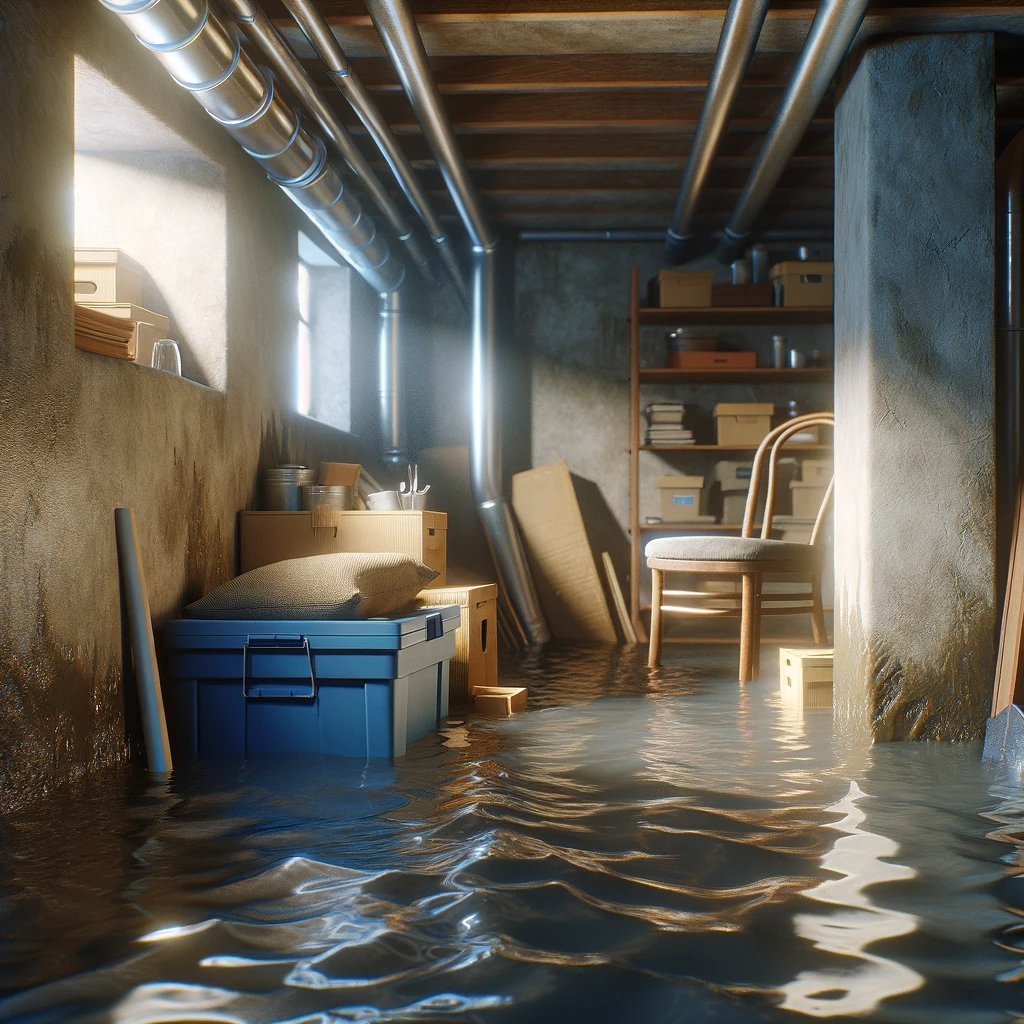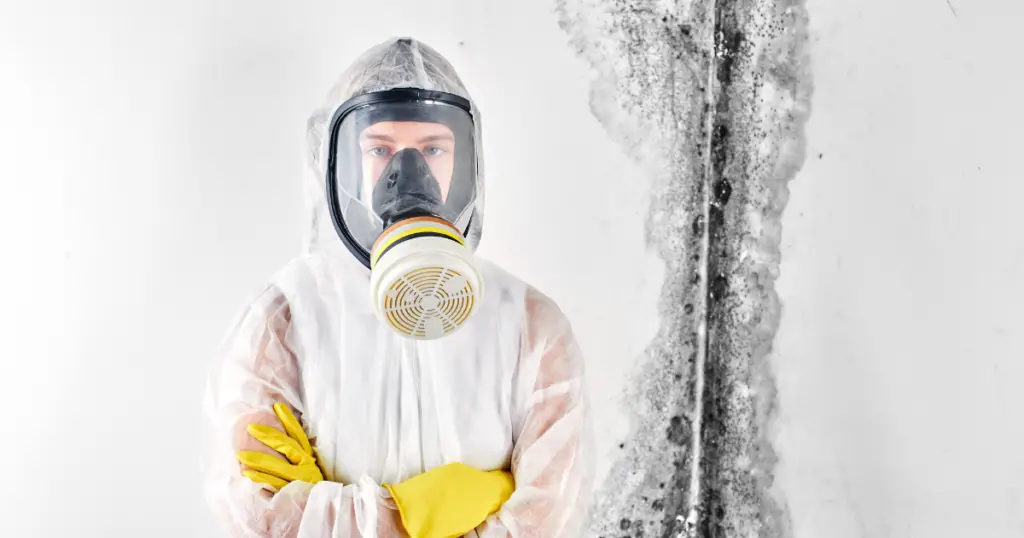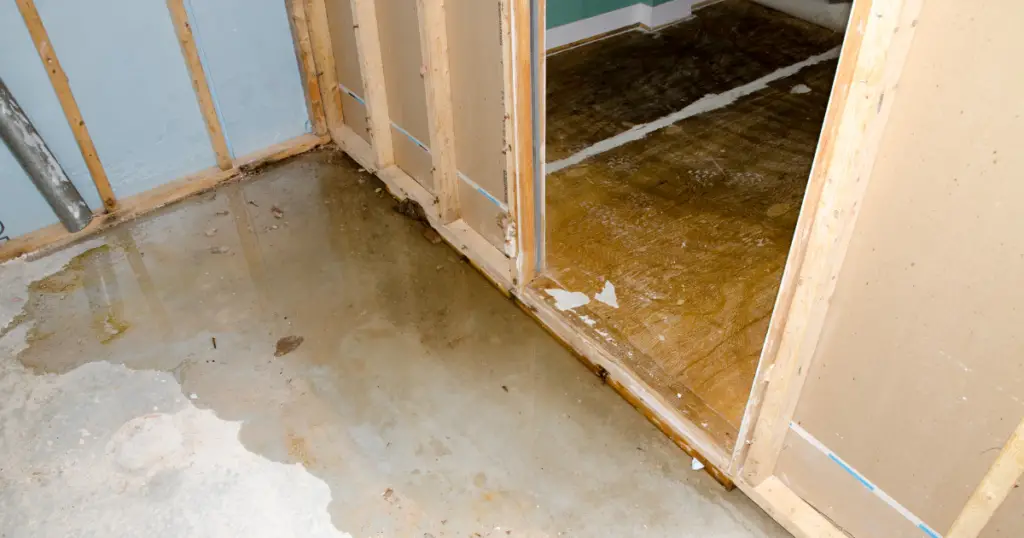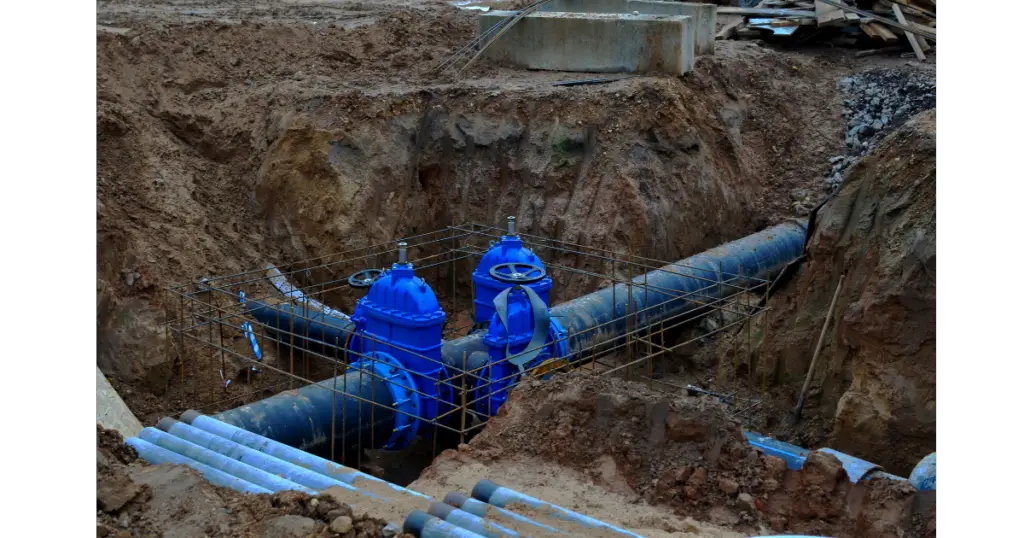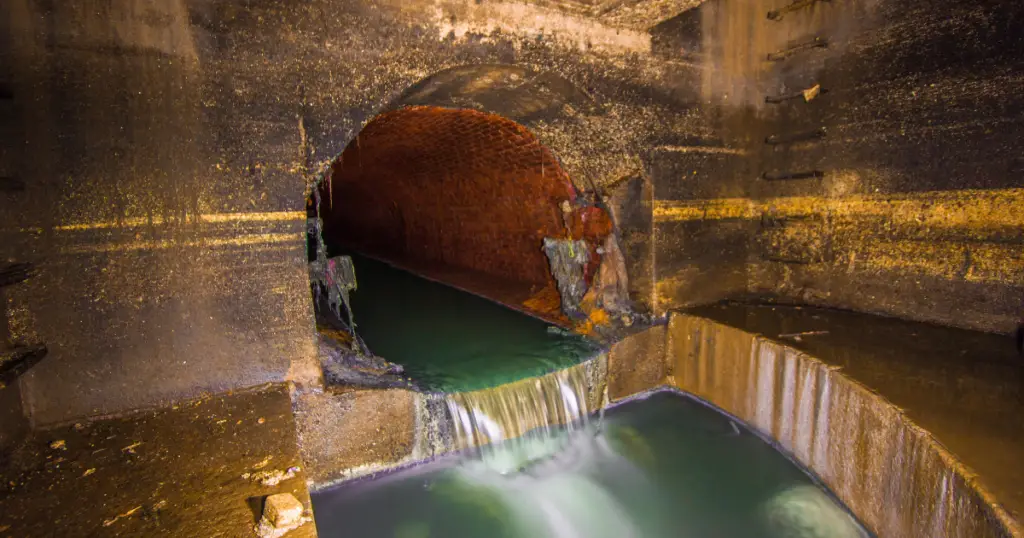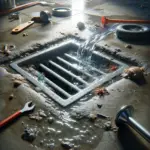Have you ever wondered what causes a sewage backup in your basement? Are damaged sewer lines, the city sewer system, or clogged basement drains to blame for your flooded basement? Whether it’s the result of an issue with your sewer system or something more widespread, understanding the cause of these backups is key to preventing them from happening.
What to do immediately when you encounter sewage backup in your basement?
In the event of a basement sewer backup, it is important to take immediate action. If standing water is visible or your basement floor drain backs up, you should immediately:
- Wear protective gear such as gloves, boots, and a face mask.
- Make sure no one enters the area to avoid any health hazards caused by contact with contaminated water.
- Turn off the electricity to avoid electric shock in case of contact with water and open as many windows as possible right away to improve ventilation and reduce odor.
- Avoid using your toilets and sinks, as they could be connected to an already flooded area.
- Pre-treat flooded areas with small splashes of chlorine bleach solution (1 part bleach and 10 parts water). This will help reduce bacteria levels in the affected area.
- If available, backwater valves can be installed on the sewer line near the house foundation which helps to stop sewage from coming back into your home during heavy rainfalls or if a city sewer system becomes overloaded.
What causes sewage backup in the basement?
Have you ever noticed a strange smell coming from the basement of your home? It could be due to a sewage backup, which could have several causes. Common sources of sewage backups include:
- Clogs: Clogs can form in any part of the home drain pipes or at any length, be it in the main line or a branch line servicing your home.
- Tree roots: When tree roots infiltrate a sewer line and reach for water, they can break apart pipes and cause serious damage.
- Damaged sewer lines: Shifts in the ground or external pressure on the sewer lines can cause them to crack and result in a sewage backup
- Heavy rainfall: When there are heavy rains the city sewers sometimes can’t handle it properly, which might result in overflowing and flooding of your basement – leading to a potential basement sewage backup and flooding.
These can lead to flooded basements, leading to contamination and putting people at risk of health hazards caused by contact with contaminated water.
Is the basement drain connected to the sewer line?
The answer to whether the basement drain is connected to the city sewer line depends on a few factors, such as the age of the home and what type of plumbing has been installed. Generally speaking, most basements will have a sewer line that runs out of the house and connects to either a municipal sewer system or a septic tank.
Common types of pipes include:
- Clay Piping: Clay pipes are very durable and have been used for centuries. They are made from natural clay that is fired in a kiln to create long-lasting pipe segments.
- Orangeburg: Orangeburg pipes are made from rolled-up layers of wood pulp material impregnated with asphalt. These pipes were commonly used in homes built before 1960 because they were inexpensive and easy to install.
- Cast Iron: Cast iron piping is another common type of material used in sewer lines due to its durability and resistance to corrosion. While these pipes have been known to last for decades with proper maintenance, they can still deteriorate over time due to corrosion or rusting.
- Plastic/ABS Pipes: Plastic pipes such as PVC (polyvinyl chloride) or ABS (acrylonitrile butadiene styrene) pipes are becoming more widely used due to their light weight, ease of installation, and affordability. These materials offer good resistance against corrosion, although they may not be able to withstand extreme temperature changes or acidic environments as well as metal alternatives like cast iron piping
What are the signs of sewage backup in basements?
Sewage backup in basements can be a major headache if not taken care of promptly. Knowing the signs that there is a problem and being able to recognize them immediately can help minimize the potential damage and get the issue fixed faster. Here are some signs that your basement might have a sewage backup:
Sewer Smell
One of the earliest warning signs of sewage backup is unpleasant sewer smells. If you start noticing this smell coming from your drains, chances are there’s a blockage in your main sewer line causing sewage to back up into your house.
Bubbling Toilets or Drains
Another sign of sewer backup is bubbling toilets or drains. When sewage starts backing up, it often causes air bubbles which can make toilets and sinks appear to be boiling or bubbling.
Slow or Clogged Drains/Toilets
A clogged toilet or drain is one of the most common signs of sewage backups in basements. If you notice that any of your toilets or drains are slow to drain, then there may be some type of blockage or clogs in either the main sewer line or one of its branches.
Standing Water/Water Coming Out Sewer Cleanout Pipe
If standing water begins accumulating around plumbing fixtures, like bathtubs and showers, then it’s likely that there’s some type of obstruction in the main sewer line causing a backup of raw sewage water. You may even spot water running out from a nearby cleanout pipe if the pressure becomes too great for it to stay inside the pipe itself.
By being aware of these signs and being on alert for them whenever you go into your basement, you can be better prepared if you ever find yourself facing a sewage backup issue in your home!
How to prevent sewage backup in the basement?
Sewage backups in the basement can be an overwhelming hassle, with potential damage and clean-up costs. But there are some simple steps you can take to help prevent basement sewage backups from occurring in your home.
Do Not Pour Grease Down Drains or Toilets
One of the main causes of sewer backups is the grease that’s poured down drains or toilets. It’s important to avoid pouring cooking oil or any other types of grease down the drain. Doing so can cause blockages in your home’s drain pipe and lead to a backup.
Install Pipes Properly
Having proper drainage is essential for preventing a sewage backup in your basement. Installing quality plumbing fixtures, a new plastic pipe, drainage pipes, and other items properly can help ensure that water flows freely through the home and doesn’t back up into the basement.
Do Not Dispose Improper Products
In addition to not disposing of cooking oil or grease, it’s also important to be mindful of what products you put down your drains and toilets. Chemicals like ammonia or bleach can corrode pipes over time, while paper towels or plastics will clog them up quickly.
Prevent Tree Roots
Tree roots are one of the most common causes of blockages in sewer lines, particularly if there are any gaps between pipe joints. If tree roots infiltrate through these cracks, then they can eventually cause sewage backups in basements by blocking off sections completely. Cut invasive tree roots and ensure that they don’t grow near your sewer system.
Backwater Prevention Valve Installation/Sewage Pump Maintenance
Sometimes installing a Backwater Prevention Valve (BPV) in your sewage system may be necessary to keep wastewater from backing up into your home. In addition, regularly inspecting and maintaining a Sewage Pump System may help prevent future issues as well.
By following these tips, you’ll hopefully be able to take proactive steps toward preventing sewage backup issues in your basement.
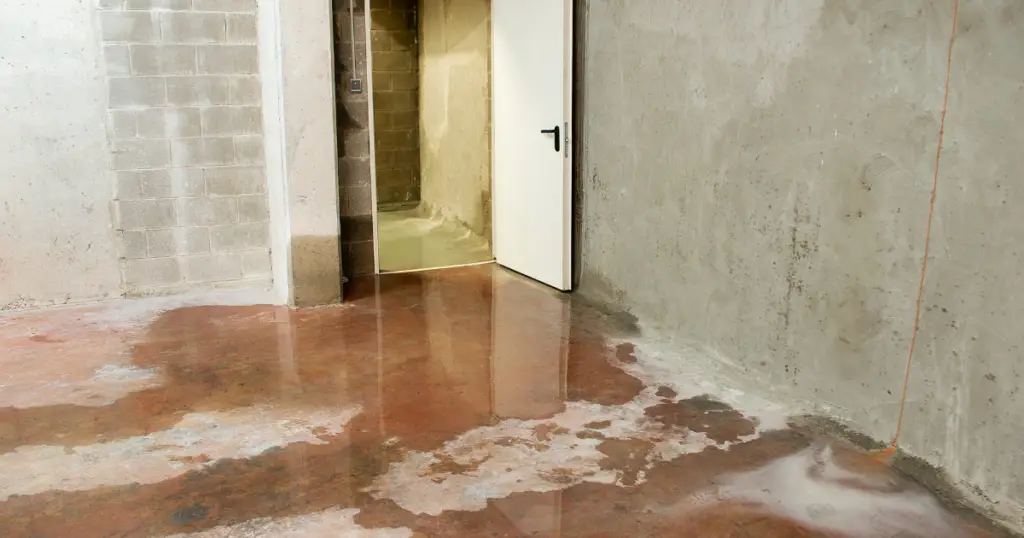
What to do with clogged drains and sewer lines?
A Clogged drain and sewer can be a serious problem, leading to costly property damage if not taken care of right away. Thankfully, there are a few steps that you can take to clear the pipes and prevent further damage.
Check Connected Sewer Lines
The first step is to determine if the clog is in an individual line or one of the connected sewer lines in your home. Take a look at all the pipes leading up to the drain or sewage line and make sure none of them have any blockages that could be causing the issue.
Use Chemical Cleaners
If checking for blockages did not fix the problem, then it may be worth trying chemical cleaners. These products contain strong chemicals that help break down any buildup in your pipes, making it easier to flush down into your main sewer line.
Call Professionals
If the clogged drain or sewage line persists after trying these methods, then it may be time to call in professionals to take a look at things. A professional plumber will be able to assess what is causing the issue and provide solutions that will prevent future problems such as basement sewage backups.
How to clean up sewage in the basement?
Protective Gear
Before beginning any work in the sewer line or dealing with sewage, make sure to wear protective gear such as rubber boots, gloves, goggles, and a face mask to protect yourself from any harmful bacteria or viruses that may be present.
Isolate the Basement
Isolate the area of the basement where sewage has backed up. This means closing any HVAC ducts or vents that may be connected to other areas of the house, preventing any further spread of bacteria or contamination. Turn off power, gas, and water lines before entering the basement.
Identify the Problem and Drain
Inspect your sewer drain and line to identify any potential issues such as cracks or blockages that could have resulted in a backup of sewage into the basement. Clear out any visible obstructions in the drain line with a plunger before attempting to scoop out or vacuum out any remaining waste.
Separate all Damaged Materials
Depending on how much material has been affected by sewage backup, this may take some time and effort to accomplish. Make sure to remove any porous items as they may contain bacteria not visible which can lead to health risks if left untreated. Remove anything that has been affected by the sewage such as carpets, furniture, drywall, insulation, etc., as these cannot be cleaned adequately and should be discarded.
Scoop it out
Using a shovel or spade, begin scooping out all of the contaminated material into buckets for disposal outside of your home. Clean up any sewage on solid surfaces such as concrete floors with a wet shop vacuum.
Take Care of the Basement Floor
Remove all damaged flooring and after removing all debris from the floor, use an absorbent material such as cat litter or sawdust to soak up smaller amounts of standing liquid to facilitate drying. If there is no standing water then skip this step.
Dry it out
Locate any air leaks around doors and windows (particularly those located at grade level) and seal them up with weatherstripping or caulking to keep fresh air circulating through your basement while drying it out thoroughly over time. You may need to utilize a dehumidifier if you continue experiencing moisture issues in your basement once you have sealed up any air leaks.
Clean All Surfaces
Scrub down all surfaces subjected to sewage backup with hot water mixed with detergent or disinfectant solution; rinse off completely afterward and allow time for everything dry thoroughly before bringing anything back into your home again. Sanitize non-porous surfaces like countertops using bleach-based products according to instructions on their labels.
Sanitize
Use appropriate cleaning products like diluted bleach solution (two tablespoons per gallon of warm water) on tiles, countertops, etcetera ensuring adequate ventilation while working within enclosed areas like cabinets and cupboards which could contain harmful fumes given off by cleaning solutions used during sanitizing efforts.
Sump Pump
Inspect and make sure it’s working properly; it should be pumping out excess water collected from rainstorms during heavy precipitation months so that your basement does not flood again which would cause further damage from mold growth due to humidity levels rising too high inside your home environment. If necessary replace sump pumps every seven years for optimal performance results according to EPA standards for aging sewage systems. Investing in a sump pump could help reduce flooding risks due to septic backups in your basement by controlling groundwater levels beneath the surface and pumping out excess water when needed thus preventing further damage caused by flooding events.
Fresh air
Open windows when able for fresh air circulation which helps dry out moisture within walls and other hard-to-reach spaces as well as filter out impurities found within contaminated air making it easier for you to breathe safely while tackling cleanup efforts within affected areas.
Keep an eye for Mold
After running through these steps you will have successfully cleaned up much of your raw sewage outbreak but it’s important that you keep an eye out for mold growth over time due to humid conditions served up by dampness left behind after flood waters recede; check corners behind furniture items and other hard-to-reach crevices often so that you can catch any additional issues early on before they become too large of problems later on down the line!
Inspect the Area
Finally, inspect the area once more for any residual contamination, and make sure that you have removed all sewage-saturated insulation, drywall, and all surfaces before bringing anything back into your home again. Sewage disasters are no joke so be sure to take the necessary steps to protect yourself and your family from any potential health risks associated with raw sewage.
Finally, Clean yourself up before leaving the area, make sure you have thoroughly washed and disinfected your hands, arms, and any exposed skin. It is important to take these precautions to ensure that you do not bring any contamination to other areas of your house.
Does Bleach kill sewage?
Bleach is a common disinfectant used for cleaning, but it does not necessarily kill all types of sewage. While bleach is effective at killing most bacteria and viruses, it may not be effective at killing certain parasites or chemicals that can be found in sewage. It is important to use other disinfectants such as chlorine or bromine when working with sewage to ensure that dangerous pathogens are eliminated.
How do you get rid of sewage backup smells in the basement?
Sewage backup smells are unpleasant and can cause health problems. To get rid of the nasty odor, here are some steps you can take:
If your basement still smells like sewage even after a thorough cleaning, the most likely culprits are your pipes, vents, or drains. This means that the first thing you must do is identify the specific source (or sources) of the offending odor.
- Water still trapped: Check to see if there is any standing water that may need to be pumped out.
- Ventilation: Make sure the area has proper ventilation. Vent fans, open windows, and dehumidifiers can help reduce odor levels.
- Use odor-eliminating products: There are many products available that can help eliminate bad smells from basements caused by sewage backups including air fresheners, deodorizers, sprays, and even candles designed specifically for this purpose.
- Install ventilation systems: To prevent future odors from occurring, consider installing fans or ventilation systems in your basement to provide better airflow and reduce the buildup of nasty smells over time.
What to do if I get exposed to sewage?
come into contact with sewage, it’s important to take precautions to protect your health. Here are some steps you should take:
- Wash with soap and water: Quickly wash any affected areas of your skin with soap and warm water as soon as possible.
- Clean contaminated clothing: Place the contaminated clothing in a sealed bag, then thoroughly clean all items using laundry detergent and hot water.
- Disinfect surfaces: Use a disinfectant solution to clean any surfaces that may have been exposed to sewage (e.g., floors, countertops, etc.).
- Seek medical attention: If you experience any signs or symptoms of illness associated with exposure to sewage (e.g., nausea, vomiting, diarrhea, fever), seek medical attention immediately.
- Avoid contact with eyes or mouth: To prevent possible ingestion or absorption of harmful bacteria from the sewage, avoid contact with your eyes or mouth at all times when dealing with sewage spills or backups in the environment.
How Dangerous is backed-up sewage?
Sewage backup can be a serious health hazard as it may contain harmful bacteria and other microorganisms. These bacteria can cause skin infections, respiratory problems, and other illnesses. Additionally, the high level of humidity in basements caused by sewage backups can create an environment that is conducive to mold growth. Mold spores can trigger allergies or asthma attacks in some individuals. It’s important to take the necessary steps to protect your health and safety if there is a sewage backup in your home.
What are the health risks of a sewage backup?
Sewage backups can present significant health risks due to the potential for contact with harmful bacteria, viruses, and parasites. The following are some of the most common illnesses associated with contact with contaminated water from a sewage backup:
- Gastrointestinal infections: This type of infection is caused by ingesting food or drink that has been exposed to contamination from fecal matter in sewage. Symptoms may include vomiting, diarrhea, fever, abdominal pain, and nausea.
- Respiratory diseases: Exposure to airborne toxins from sewers can cause respiratory illnesses such as asthma and bronchitis.
- Wound infections: Infections can occur when an open wound comes into contact with contaminated water.
- Bloodborne infections: Bloodborne infections such as Hepatitis B/C can be contracted if an individual has an open wound that comes into contact with contaminated water.
It is important to take all necessary safety precautions when dealing with a sewage backup to protect yourself from illness and infection.
Are sewage backups covered by any insurance company?
In most cases, homeowners insurance does not cover the costs associated with a sewage backup. This type of damage is typically excluded in homeowners’ policies because it often results from external causes such as a clogged pipe or sewer main. Homeowners should check their policy carefully to determine if they have coverage for sewage backup-related damages. If a homeowner does not have coverage, they may be able to purchase an endorsement or additional policy to protect against this type of damage.
Professional Help
When it comes to dealing with sewer systems issues, it is beneficial to seek the help of a professional restoration company. With their expertise and specialized knowledge in this area, they can provide invaluable insights and guidance. Additionally, they can offer safe and effective solutions that can restore plumbing systems to normal. Here are some of the key benefits that professional restoration companies provide:
- Expertise: They have extensive experience in handling sewer system issues. They understand the intricate components involved and know the best methods for resolving any issue that may arise.
- Objectivity: They can view the situation objectively and devise an appropriate solution without being influenced by emotions or personal biases.
- Support: In addition to providing exceptional service, these professionals will also offer ongoing support throughout the process of fixing your sewer system. This includes offering advice about prevention strategies and providing emotional support during difficult times.
Ultimately, enlisting the assistance of a professional offers numerous benefits and can help to ensure that any sewage backup is dealt with quickly and effectively.
[/et_pb_text][/et_pb_column][/et_pb_row][/et_pb_section]
